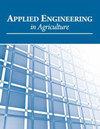含水率和细度对颗粒物料休止角的影响
IF 0.9
4区 农林科学
Q4 AGRICULTURAL ENGINEERING
引用次数: 1
摘要
在不同类型的颗粒中,研究了水分含量和颗粒细度对休止角(AoR)的影响。充填休止角(AoR)随含水率的增加而增大,但保持在“自由流动”范围内。排空和倾斜台AoR受额外水分和细粒的影响更大。利用图像分析成功地测量了静止角。生物质和饲料颗粒可以使用类似于用于其他散装材料的设备来处理和储存;然而,他们独特的身体特征可能导致处理挑战。了解这些材料的流动特性对于处理和存储系统的设计是必不可少的,但是这些特性在不太理想的条件下没有很好的定义。本研究的总体目标是评估水分含量和细颗粒水平如何影响硬木、松木垫层和饲料颗粒的休止角(AoR)。评估了三种湿度水平(无条件、高于平衡两个和四个百分点)和四种颗粒细度水平(0%、5%、10%和15%细度)。评估了多种测量AoR的方法,包括固定漏斗(包括损失和受限底座),倾斜台和清洁的测试夹具,以同时测量排空和填充AoR。开发了一种图像分析工具,使用折线拟合颗粒边界,并用于测量各自的角度。随着颗粒类型和AoR测量方法的不同,水分和细粒水平的增加对AoR的影响也有所不同,但通常会导致AoR的增加。灌浆(动态)AoR受水分和细粒水平的影响最小,细粒水平之间无差异,水分水平之间差异有限。倒空(静态)AoR与倾斜台法呈线性相关,但倾斜台AoR平均高15.5°。利用组合测试夹具,硬木、松木垫层和饲料颗粒的总体填充(动态)AoR(包括所有水分含量和百分比精细水平)分别为33.8°、35.0°和35.4°,而排空(静态)AoR为39.9°、44.2°和42.7°。关键词:休止角,生物量,含水率,粒径,球团,物理性能本文章由计算机程序翻译,如有差异,请以英文原文为准。
Influence of Moisture Content and Fine Levels on Angle of Repose for Pelletized Materials
HighlightsThe influence of moisture content and fine levels on the angle of repose (AoR) was evaluated for multiple pellet types.Filling angle of repose (AoR) show some increases with moisture, but values remained in the “free-flowing” range.Emptying and tilting table AoR were more impacted by additional moisture and fines.Image analysis was successfully used to measure the angle of repose.Abstract. Biomass and feed pellets can be handled and stored using similar equipment to that used for other bulk materials; however, their unique physical characteristics can lead to handling challenges. Understanding the flow characteristics of these materials is essential for handling and storage system design, but these characteristics are not well defined in less-than-ideal conditions. The overall objective of this study was to evaluate how moisture content and level of fines influence the angle of repose (AoR) of hardwood, pine bedding, and feed pellets. Three moisture levels (unconditioned, two and four percentage points above equilibrium) and four particle fine levels (0%, 5%, 10%, and 15% fines) were evaluated. Multiple methods for measuring AoR were assessed, including the fixed funnel (both lose and confined base), tilting table, and a clear-sided test fixture to measure emptying and filling AoR simultaneously. An image analysis tool using a polyline fit to the pellet boundary was developed and used to measure the respective angles. The impact of increasing moisture and fine levels varied by pellet type and AoR measurement method, but generally resulted in an increase in AoR. The filling (dynamic) AoR was least impacted by moisture and fine levels, showing no differences among fine levels, and limit differences among moisture levels. Emptying (static) AoR was linearly correlated with the tilting table method, but the tilting table AoR was on average 15.5° higher. Utilizing the combined test fixture, the overall filling (dynamic) AoR for hardwood, pine bedding, and feed pellets inclusive of all moisture contents and percent fine levels were 33.8°, 35.0°, and 35.4°, respectively, while emptying (static) AoR’s were 39.9°, 44.2°, and 42.7°. Keywords: Angle of repose, Biomass, Moisture content, Particle size, Pellets, Physical properties.
求助全文
通过发布文献求助,成功后即可免费获取论文全文。
去求助
来源期刊

Applied Engineering in Agriculture
农林科学-农业工程
CiteScore
1.80
自引率
11.10%
发文量
69
审稿时长
6 months
期刊介绍:
This peer-reviewed journal publishes applications of engineering and technology research that address agricultural, food, and biological systems problems. Submissions must include results of practical experiences, tests, or trials presented in a manner and style that will allow easy adaptation by others; results of reviews or studies of installations or applications with substantially new or significant information not readily available in other refereed publications; or a description of successful methods of techniques of education, outreach, or technology transfer.
 求助内容:
求助内容: 应助结果提醒方式:
应助结果提醒方式:


